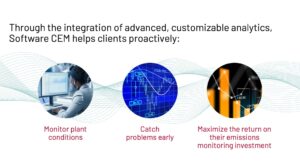Elevating Emissions Monitoring
Transforming Compliance into Strategic Advantage with Software CEM
What if you could determine you had a potential problem with your Hardware Continuous Emissions Monitoring (CEM) before it failed?
Imagine being able to spot a failure in your Hardware Continuous Emissions Monitoring (CEM) system before it turns into a costly disaster—how much more efficient and effective could your operations be if you could catch issues before they arise?
With Software CEM®, you can do just that.
In today's industrial environment, where efficiency and uptime are critical to profitability, Software CEM can offer more than regulatory compliance.—It’s a strategic asset. By transforming emissions data into actionable insights, it empowers your organization to gain a measurable edge over the competition

Through the integration of advanced, customizable analytics, Software CEM helps clients proactively:
- Monitor plant conditions like model drift or failure
- Catch problems in equipment early
- Maximize the return on their emissions monitoring investment
Beyond Compliance: Proactive, Model-Based Monitoring
Organizations need a way to correlate real-time site or location data with forecasted models. However, the information is often siloed, unavailable or inaccessible in a timely and automated manner for the workforce to proactive react to a problem. That’s where Software CEM advanced analytics can help. For instance, a model built around damper position can highlight discrepancies between expected and actual behavior. When deviations are detected, the system can automatically alert plant personnel, prompting timely checks before problems escalate.
This proactive strategy empowers clients to take action based on predictive insights, rather than waiting for alarms or failures. It also adds significant value for the money spent on Software CEM, turning what many consider a regulatory obligation into a powerful operational asset.
Bridging the Skills Gap
A critical barrier for many facilities—especially in sectors like food & beverage and ethanol production—is the lack of internal resources to build or maintain these analytics. Unlike high-margin industries such as oil and gas, which often employ onsite process modeling experts, many lower-margin operations simply don’t have the bandwidth to develop or act on sophisticated models.
Software CEM can remove that barrier by delivering ready-to-use, expert-built analytics as part of the core offering. Clients don’t need to hire specialized talent—the system delivers actionable intelligence out-of-the-box. This capability also extends to remote diagnostics, allowing users to analyze and troubleshoot issues at facilities located hundreds of miles away, saving time and reducing the need for site visits.
Analytics That Fit Any Application
One feature organizations should be considering with their Software CEM is adaptability. A platform capable of generating advanced analytics from any emissions monitoring input—and tailoring predictive models to the unique variables of each facility—offers a significant competitive advantage. This ensures insights are not only adaptable to real time shifts, but also operationally relevant and scalable across the business. Whether the application is large-scale, like in a chemical or oil refinery, or smaller and more focused like in an ethanol plant, Software CEM can scale accordingly.
Examples of these use cases include:

- Selective Catalytic Reduction (SCR) Units: Models track ammonia levels across catalyst beds. Discrepancies in ammonia distribution can lead to emissions violations or process inefficiencies, and the model quickly flags such issues for intervention.
- Oxygen Sensors: In combustion processes, accurate O₂ measurement is essential. Models compare field data from O₂ analyzers (which typically operate within a ~3% range) to ideal targets. If O₂ drops below 1.5%, there's a risk of generating carbon monoxide; if too high, fuel is wasted. Software CEM alerts operators when sensors show values outside the acceptable range, possibly indicating a probe issue or combustion imbalance.
Your organization can use these existing models to enhance reliability, efficiency, and compliance—all without needing additional capital investment or manual analysis.
Overcoming Challenges, Delivering Results
While building and maintaining accurate models does come with challenges, such as varying process conditions, hardware inconsistencies, and change management. You need a partner with operational and technical experience to mitigate those hurdles. The result is a platform that not only meets regulatory needs but unlocks new opportunities for cost savings, process improvement, and long-term competitive advantage.
Final Thoughts
Transform continuous emissions monitoring from a reactive, compliance-driven task into a proactive, value-generating function. By continuously comparing real-time data to intelligent models, issuing timely alerts, and adapting analytics to any process input, Software CEM provides a modern solution for plants seeking more than just compliance. Continuous emission monitoring and compliance is an industry where most competitors stop at measurement, data collection, and compliance. Using Software CEM, your organization can go further, leveraging the emission monitoring investment to delivering actionable insights unlocking efficiency, opportunities, cost savings and long-term value.


